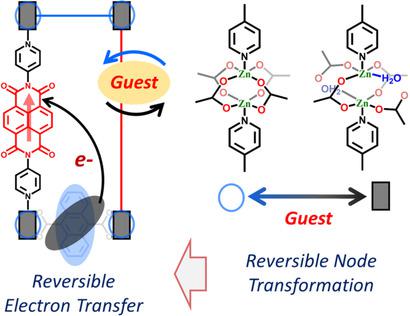当前位置:
X-MOL 学术
›
Angew. Chem. Int. Ed.
›
论文详情
Our official English website, www.x-mol.net, welcomes your
feedback! (Note: you will need to create a separate account there.)
Guest-Responsive Reversible Electron Transfer in a Crystalline Porous Framework Supported by a Dynamic Building Node.
Angewandte Chemie International Edition ( IF 16.1 ) Pub Date : 2020-07-11 , DOI: 10.1002/anie.202008189 Nivedita Sikdar 1 , Arpan Hazra 1 , Debabrata Samanta 1 , Ritesh Haldar 2 , Tapas Kumar Maji 1, 2
Angewandte Chemie International Edition ( IF 16.1 ) Pub Date : 2020-07-11 , DOI: 10.1002/anie.202008189 Nivedita Sikdar 1 , Arpan Hazra 1 , Debabrata Samanta 1 , Ritesh Haldar 2 , Tapas Kumar Maji 1, 2
Affiliation

|
We demonstrate a redox‐active, crystalline donor–acceptor (D‐A) assembly in which the electron transfer (ET) process can be reversibly switched. This ET process, induced by a guest‐responsive structural transformation at room temperature, is realized in a porous, metal–organic framework (MOF), having anthracene (D)–naphthalenediimide (A) as struts. A control MOF structure obtained by a solvent‐assisted linker exchange (SALE) method, replacing an acceptor strut with a neutral one, supported the switchable electronic states in the D‐A MOF. Combined investigations with X‐ray diffraction, spectroscopy, and theoretical analyses revealed the dynamic metal paddle‐wheel node as a critical unit for controlling structural flexibility and the corresponding unprecedented ET process.
中文翻译:

动态建筑节点支持的晶体多孔框架中的客体响应可逆电子转移。
我们演示了一种具有氧化还原活性的晶体供体-受体(D-A)组件,在其中可以可逆地切换电子转移(ET)过程。这种ET过程是由室温下客体响应的结构转变引起的,是在以蒽(D)-萘二酰亚胺(A)为支撑物的多孔金属有机框架(MOF)中实现的。通过溶剂辅助接头交换(SALE)方法获得的控制MOF结构,用中性受体取代了受体支杆,支持了D-A MOF中的可切换电子状态。与X射线衍射,光谱学和理论分析相结合的研究表明,动态金属桨轮节点是控制结构灵活性和相应的前所未有的ET过程的关键单元。
更新日期:2020-07-11
中文翻译:

动态建筑节点支持的晶体多孔框架中的客体响应可逆电子转移。
我们演示了一种具有氧化还原活性的晶体供体-受体(D-A)组件,在其中可以可逆地切换电子转移(ET)过程。这种ET过程是由室温下客体响应的结构转变引起的,是在以蒽(D)-萘二酰亚胺(A)为支撑物的多孔金属有机框架(MOF)中实现的。通过溶剂辅助接头交换(SALE)方法获得的控制MOF结构,用中性受体取代了受体支杆,支持了D-A MOF中的可切换电子状态。与X射线衍射,光谱学和理论分析相结合的研究表明,动态金属桨轮节点是控制结构灵活性和相应的前所未有的ET过程的关键单元。











































 京公网安备 11010802027423号
京公网安备 11010802027423号